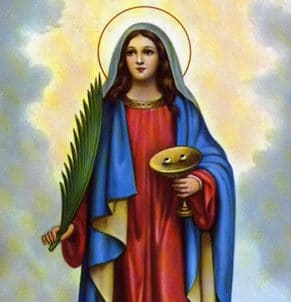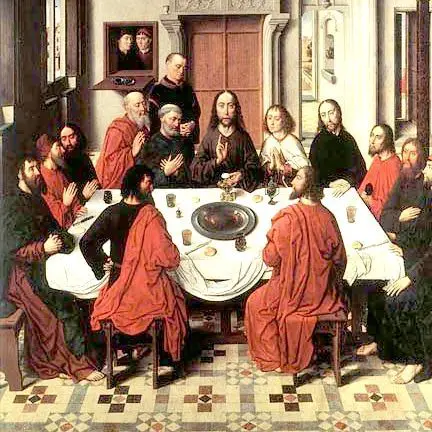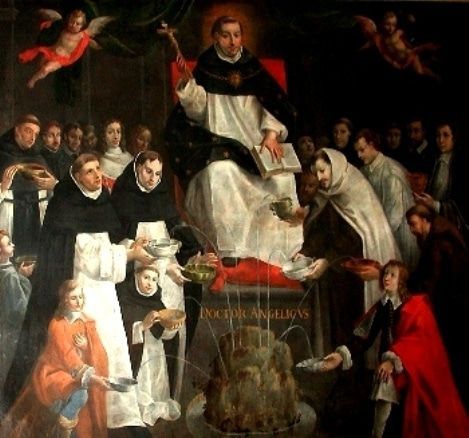Read our article about the story of Saint Catherine of Alexandria, a Christian martyr of the first centuries who never gave up her faith in Christ.
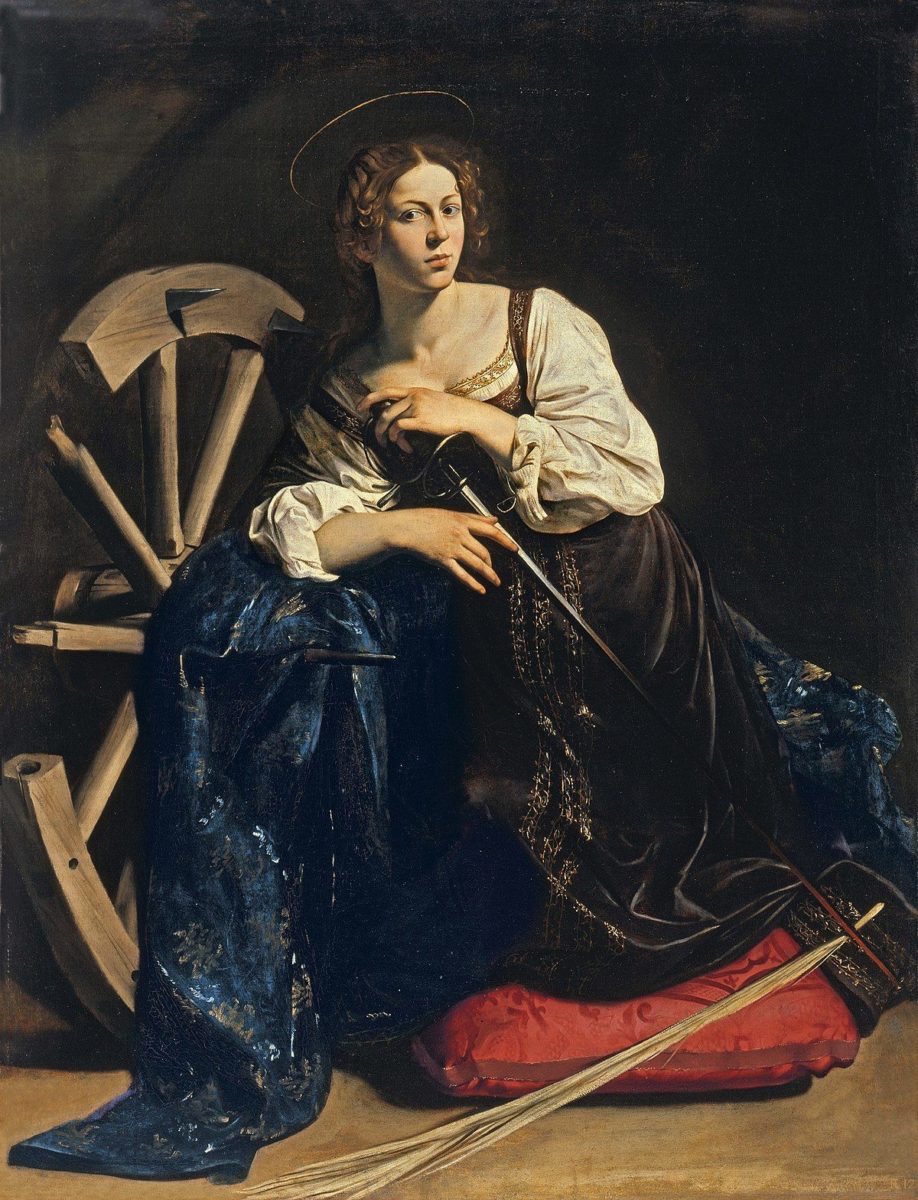
History and biography of Saint Catherine of Alexandria
Saint Catherine of Alexandria is a canonised saint of the Catholic Church who, according to Christian tradition, was martyred in Alexandria, Egypt, around the year 305.
Of course, the early Christian church was not divided. She is also recognised as a great martyr and saint by the Orthodox religion.
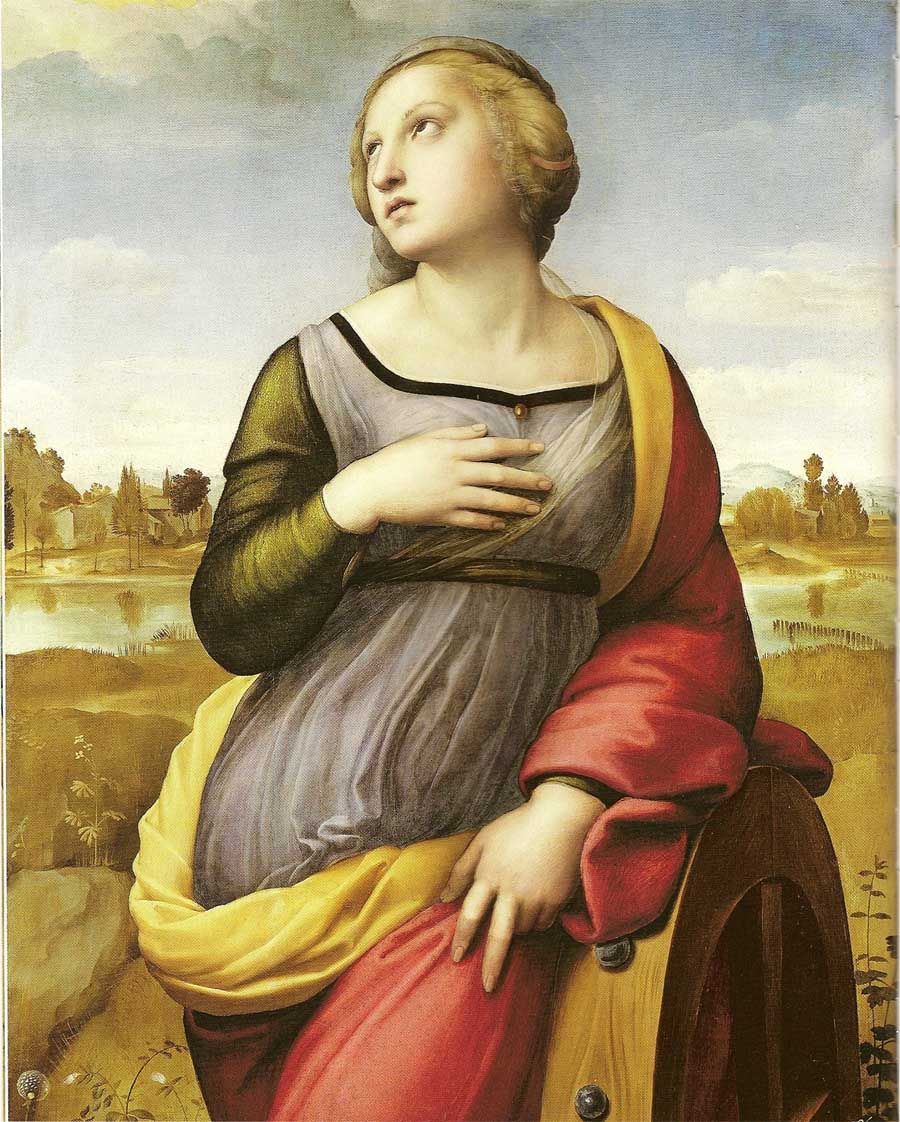
There are no surviving primary sources attesting to her existence, but the fact that her memory and the stories about her have been kept alive and passed down in tradition certainly confirms her existence and her life of heroic virtue and holiness.
The young saint was born around the year 287 in Alexandria, Egypt. At that time, Alexandria was one of the most beautiful cities in the world and a centre of learning, culture and faith.
According to Christian tradition, she was of noble birth, possibly a princess. As a member of the nobility, she was also educated and a keen scholar.
At the age of fourteen, she had a moving vision of Mary and the infant Jesus and decided to become a Christian.
Although she was a teenager, she was very intelligent and talented. When the Emperor Maxentius began to persecute Christians (See: Why the early Christians were persecuted), Catherine visited him to denounce his cruelty.
Instead of ordering her execution, Maxentius summoned fifty orators and philosophers to debate her. But Catherine was moved by the power of the Holy Spirit and spoke eloquently in defence of her faith.
Her words were so moving that many of the pagans converted to Christianity and were immediately executed.

Unable to defeat her rhetorically or intimidate her into abandoning her faith, the emperor ordered her tortured and imprisoned.
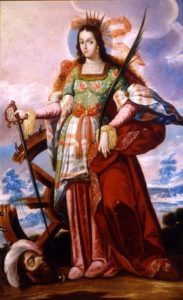
Catherine was arrested and flogged. Despite the torture, she did not give up her faith. So it was with St Agnes, another martyred Christian. News of her arrest and the power of her faith spread quickly and more than 200 people visited her.
According to some legends, the emperor’s own wife, Valeria Maximilla, was converted by Catherine. The emperor eventually executed his own wife for her conversion. However, this is not mentioned in the historical record and may be a legend. It is believed that Maximilla was alive and with her husband at the Battle of the Milvian Bridge in 312, seven years after Catherine’s death.
After her imprisonment, Maxentius made a last-ditch attempt to persuade the beautiful Catherine to abandon her faith by proposing marriage. This would have made her a powerful empress. Catherine refused, saying that she was married to Jesus Christ and that her virginity was dedicated to him.
The furious emperor ordered her to be executed on a wheel. The breaking wheel is an ancient form of torture in which a person’s limbs are twisted between the spokes and their bones are crushed by an executioner with a heavy rod.
It is a brutal punishment that results in a slow and painful death, usually reserved for the worst criminals. As Catherine stood before the executioner, she touched him and a miracle occurred, causing the wheel to break.
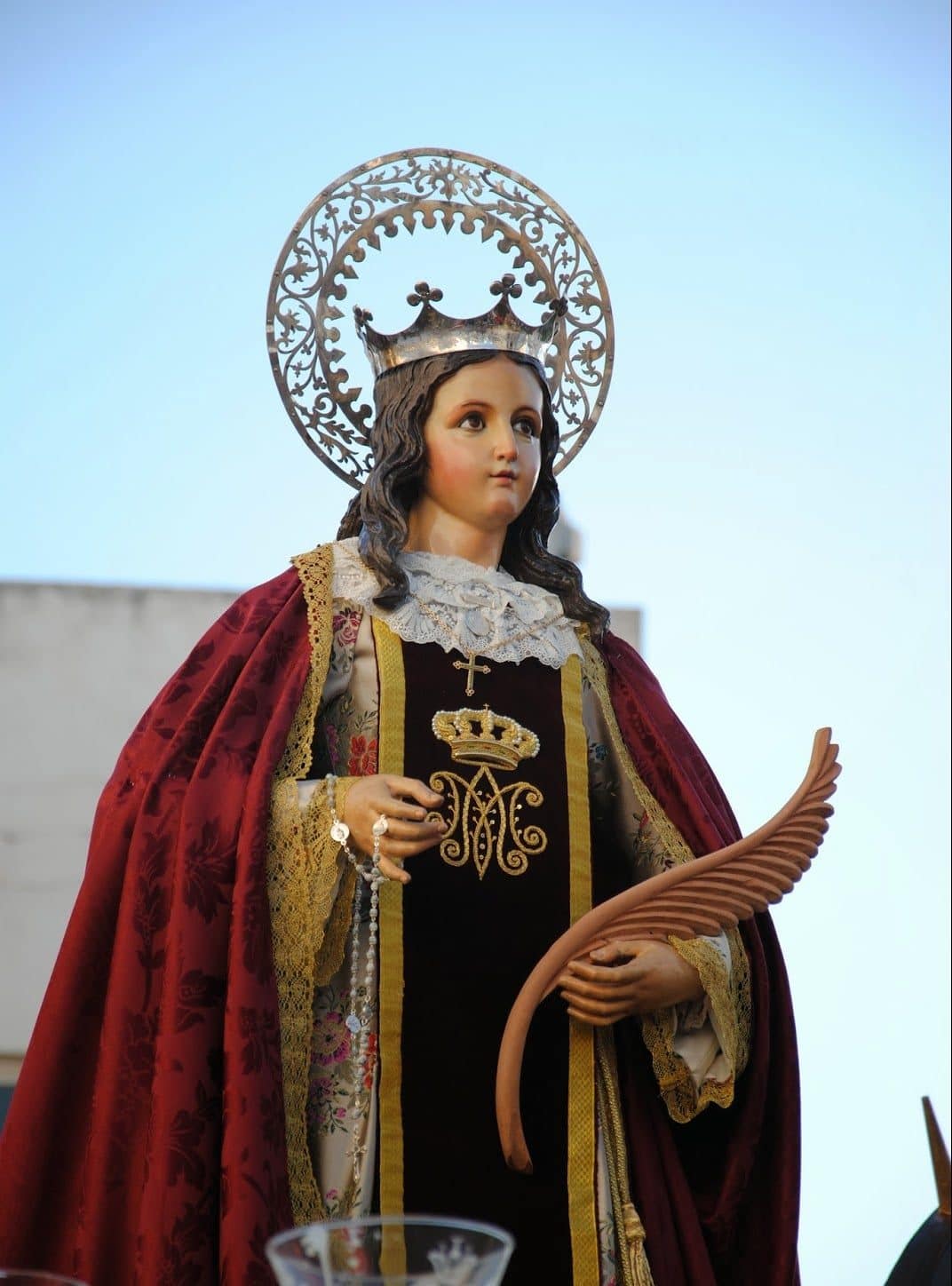
Unable to torture her to death, the emperor simply ordered her beheaded. This was the way St George of Cappadocia died.
Around the year 800, the legend spread that his body had been found with his hair still growing and a steady stream of oil coming from his body. To this day, nothing has been found of his remains and his very existence has been questioned.
Discover the story of this saint in this excellent video:
Despite these questions, and the possibility that her story may be confused with that of one or more other saints, she is still venerated as a martyr in the Eastern Orthodox Church.
Many Roman Catholics still venerate her as one of the great virgin saints of the early Church.

During the Middle Ages, St Catherine was one of the most famous saints of the Church. She was a popular subject in Renaissance art and many paintings of the period are dedicated to her.

St Catherine of Alexandria remains a very popular Catholic name. The spiked wheel is a popular symbol often associated with St Catherine. She died at a very young age, as did Saint Sebastian.
Her feast day is 25 November and she is the patron saint of many professions and causes. She is the patron saint of students, unmarried girls, apologists and many others in many parts of the world.
St Catherine, whose erudition and spirit of piety were the reasons for her canonisation, was chosen as the model and patron saint of Christian philosophers.
Learning, together with virtue, are the noblest qualities and ornaments of the human mind. Profane science teaches many useful truths, but compared with the importance of the study of the science of the saints, it is only valuable if it is subordinate to the latter.
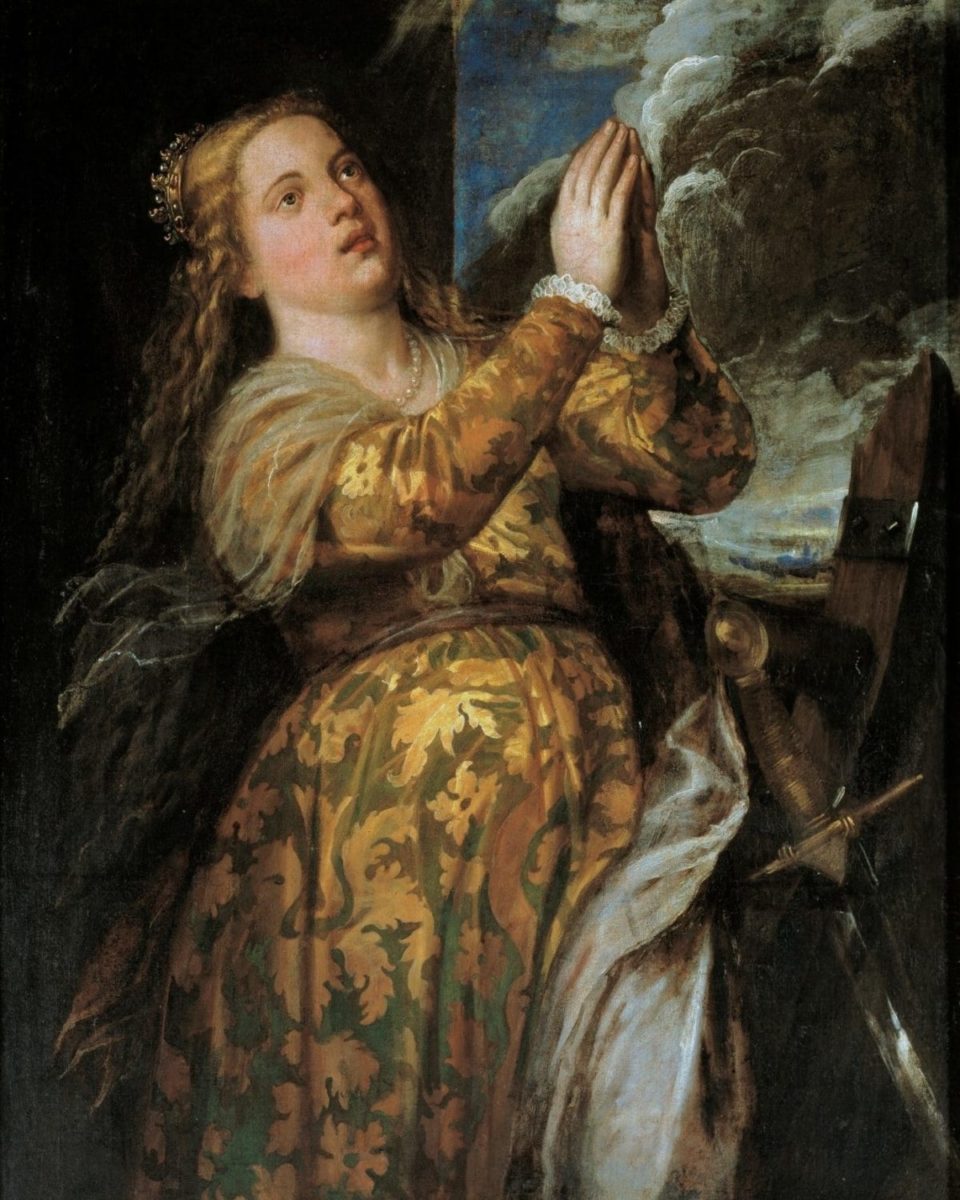
The study of the saints was to live in the spirit of Christ. This science is taught by the Church and is acquired by listening to its instructions, by pious reading and meditation.
We should try to learn this science and to order our lives according to its rules. It is the “one thing necessary” because it is the foundation of all wisdom and true happiness. “The fear of the Lord is the beginning of wisdom.
See the beautiful images of St Catherine of Alexandria in this video:
Prayer to St Catherine of Alexandria
This is a prayer to St Catherine of Alexandria, which can also be used for other saints and, of course, to God.St Catherine of Alexandria was the patron saint of students, scholars and philosophers, so she was naturally popular with the learned poets of Ireland.

Today, as with most people who have ever lived, there is no historical proof of her existence or martyrdom. But according to legend, St Catherine was a philosopher who frequented the library of Alexandria.
O God, who distinguished Your holy virgin and martyr Catherine of Alexandria by the gift of great wisdom and virtue, and by a victorious struggle with the enemies of the faith.
Through her intercession, we pray, grant us constancy in the faith and the wisdom of the saints, so that we may dedicate all the powers of our minds and hearts to Your service. Through Christ our Lord. Amen.
See in this video the prayer to St Catherine of Alexandria that you can pray every day:
Prayer to St Catherine of Alexandria for Love
Generous and loving God, we thank you for the tradition and example of St Catherine of Alexandria. Give us the grace to pursue her love of purity, to strive for her strength and courage, to adhere to her abhorrence of worldly temptations and sinful desires, and to follow her fidelity.
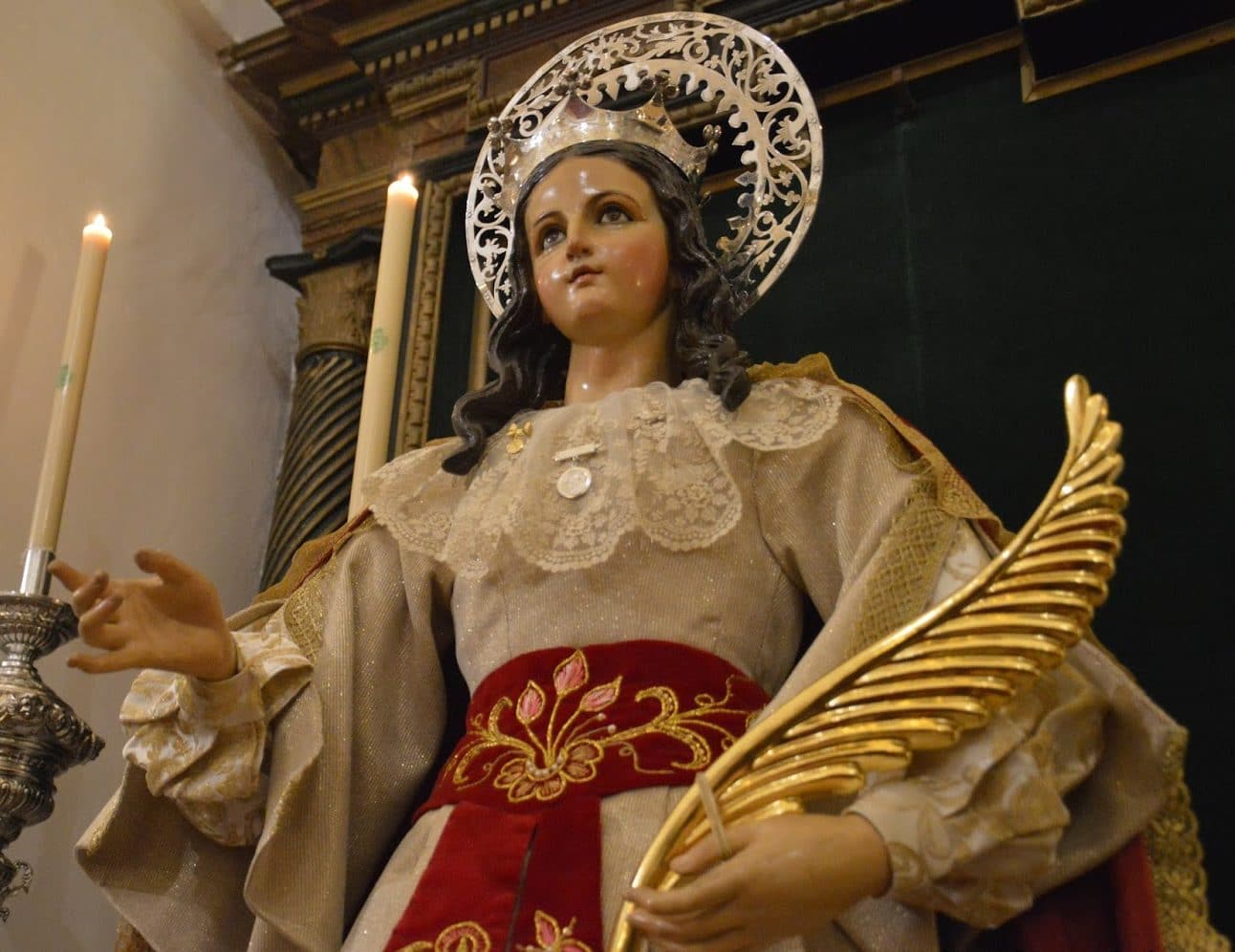
Empower us to break the wheel of worldly suffering and allow your wisdom to shine through our lives so that your glory may shine ever brighter.
We ask you, St Catherine of Alexandria, to bring us the one we love and to never forsake us. Help us to welcome those who come to your name, through Jesus Christ, our servant, who is one with you and the Holy Spirit. Amen.
Watch this video to learn more about St Catherine of Alexandria’s prayer for love:
Novena to St Catherine of Alexandria
Preliminary prayer for each day of the novena: Almighty God! With renewed faith and reverent adoration of the high investiture, I humbly kneel before You and with Your faithfulness invoke Your great goodness and mercy.
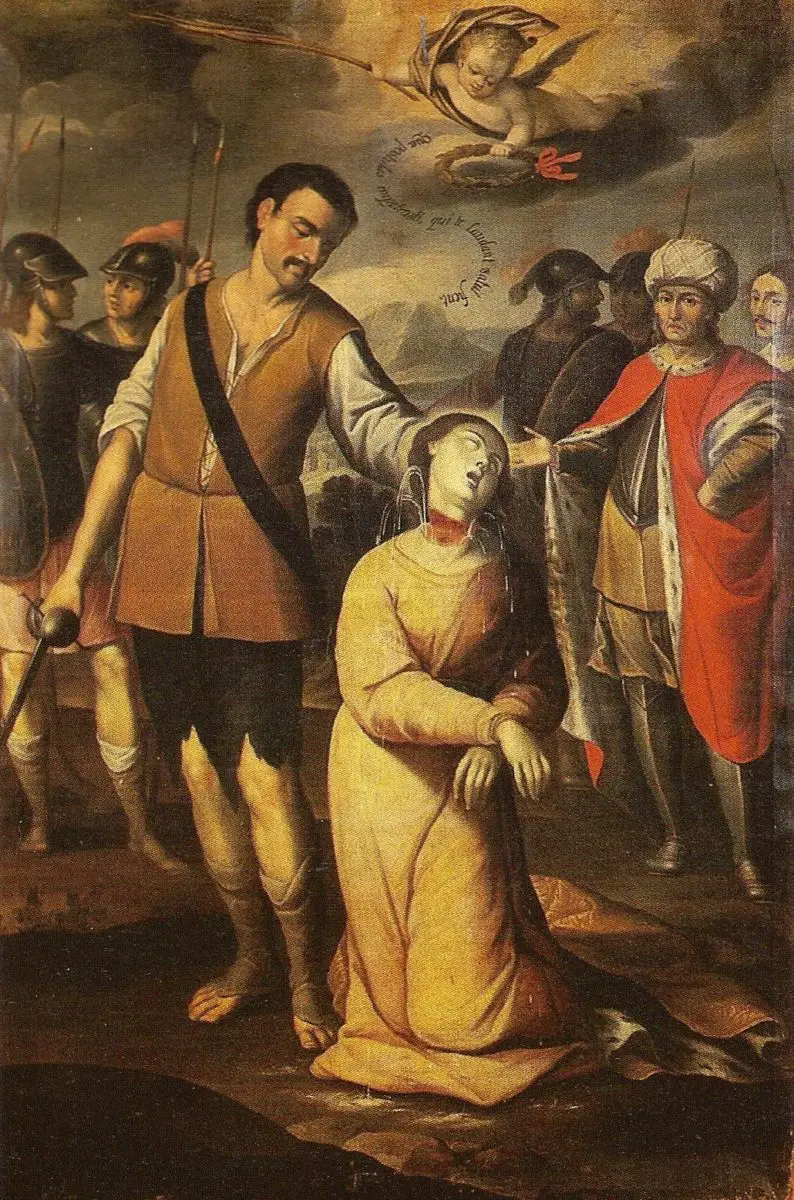
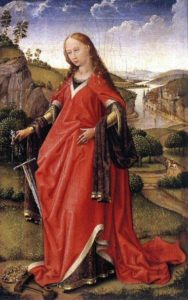
Illuminate the darkness of my mind with Your holy heavenly light and fill my heart with the warmth of Your affection.
That I may contemplate the marvellous virtues and deeds of St Catherine of Alexandria, to whom I offer this novena in her name, and in her footsteps, surrender my life to Our Lord Jesus.
I also ask You, through the merits and intercession of that mighty helper, St Catherine of Alexandria, to grant the petition which I humbly present to You, saying devoutly:
“May your holy word be effective on earth as it is in heaven. Give us the grace to listen to it, so that it may be for Your greater glory and the salvation of my soul. Amen.
Daily prayer: O God, You distinguished Your holy virgin and martyr St Catherine of Alexandria by the gift of great wisdom and virtue, and by a victorious struggle with the enemies of the faith.
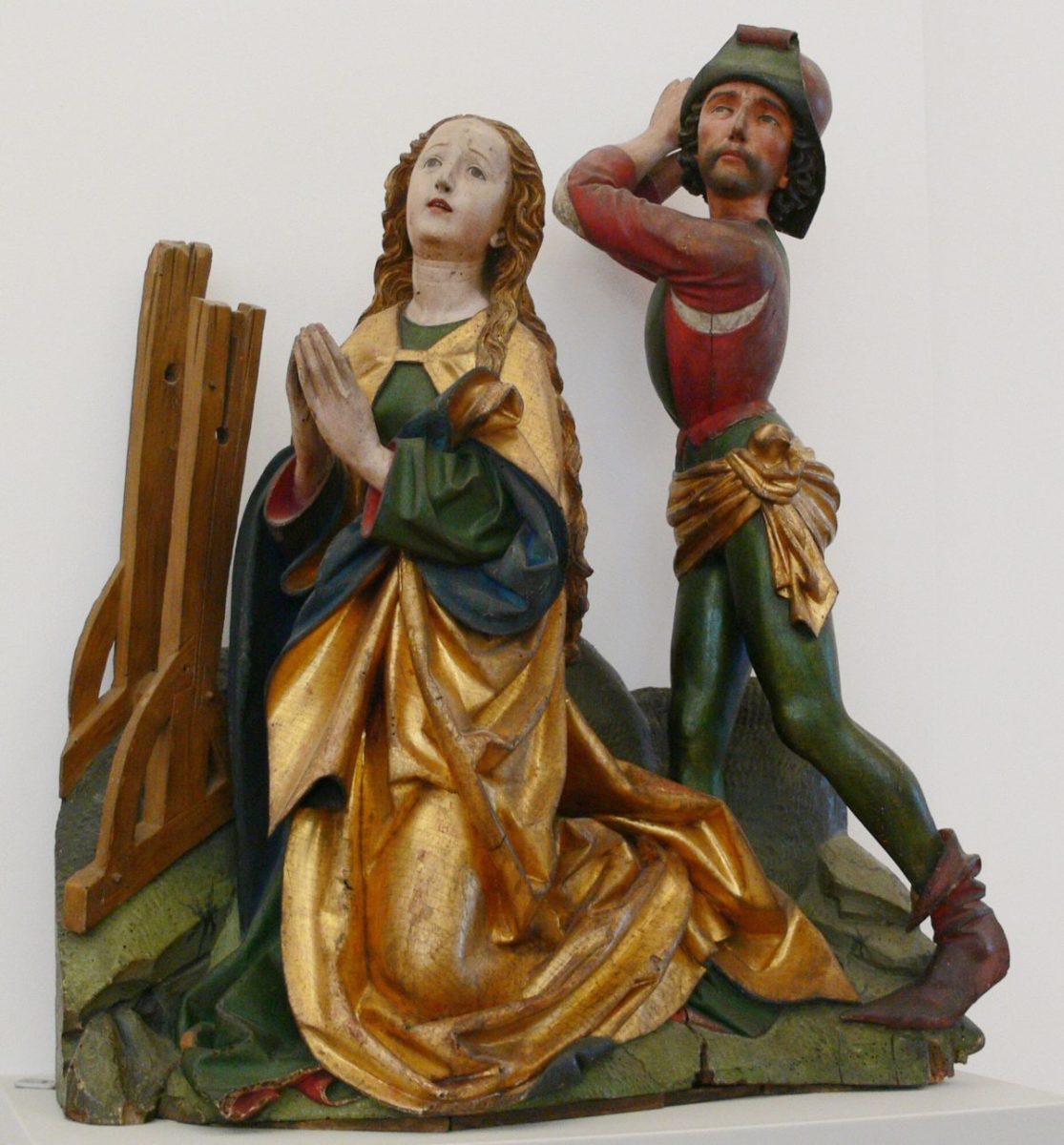
Grant us, we pray, through their intercession, constancy in the faith and the wisdom of the saints, that we may dedicate all the powers of our minds and hearts to your service. Through Christ our Lord, Amen.
Invocation of St Catherine of Alexandria: Glorious Virgin and Martyr, St Catherine of Alexandria, radiant with the splendour of wisdom and purity, your wisdom refuted the opponents of divine truth and covered them with confusion, your immaculate purity made you the spouse of Christ, so that after your glorious martyrdom the angels carried your body to Mount Sinai.
I wish for myself to progress in the science of the saints and in the virtue of holy purity, so that by overcoming the enemies of my soul I may be victorious in my last battle and after death be led by the angels to the eternal beatitude of heaven. Amen.
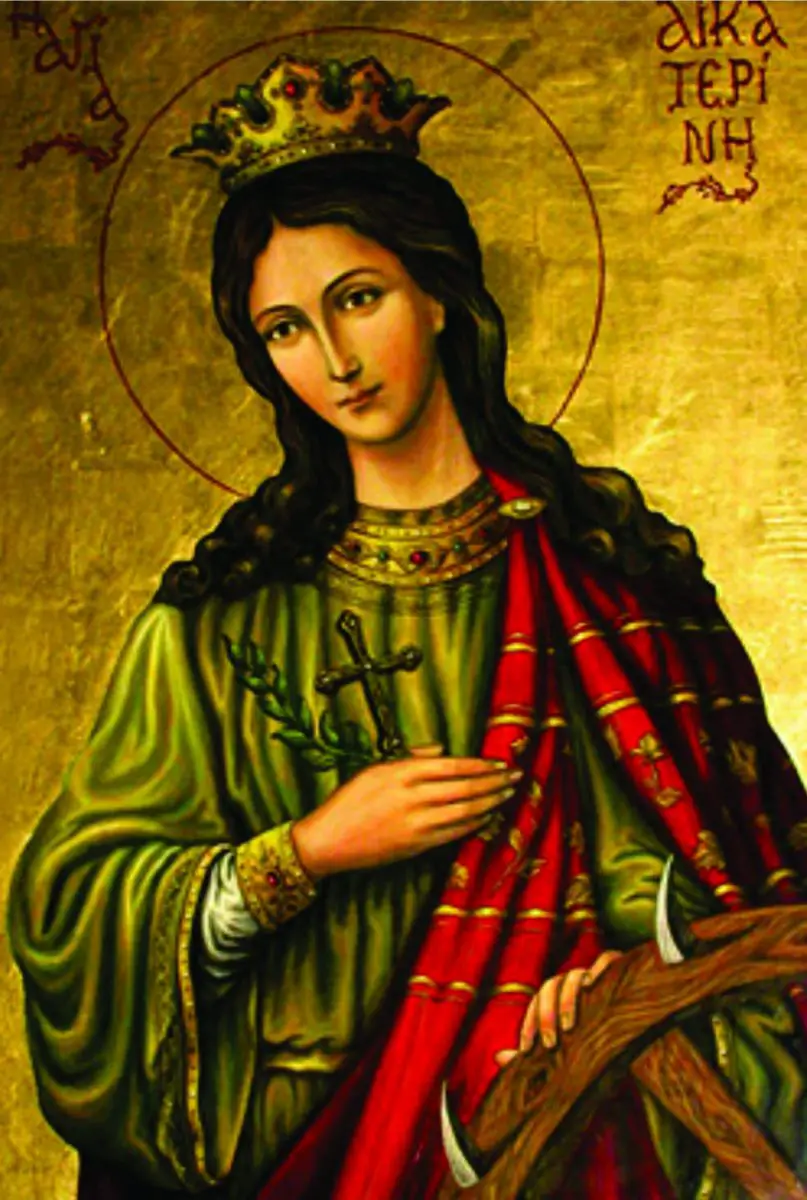
Closing prayer: O my Lord and God! I offer You my petition in union with the painful Passion and Death of Jesus Christ, Your first-born Son.
Together with the virtues of His sinless and ever-blessed Mother, the Blessed Virgin Mary, and of all the angels and saints, especially those of the Holy Help of Saint Catherine of Alexandria, in whose honour I make this novena.
Look at me, merciful Lord! Give me your grace and love, and graciously hear my prayer. Amen.
Prayer to St Catherine of Alexandria for single women
The feast of St Catherine of Alexandria is on 25 November, just before the beginning of Advent, a time in the Middle Ages and for many years afterwards when no weddings could be celebrated.
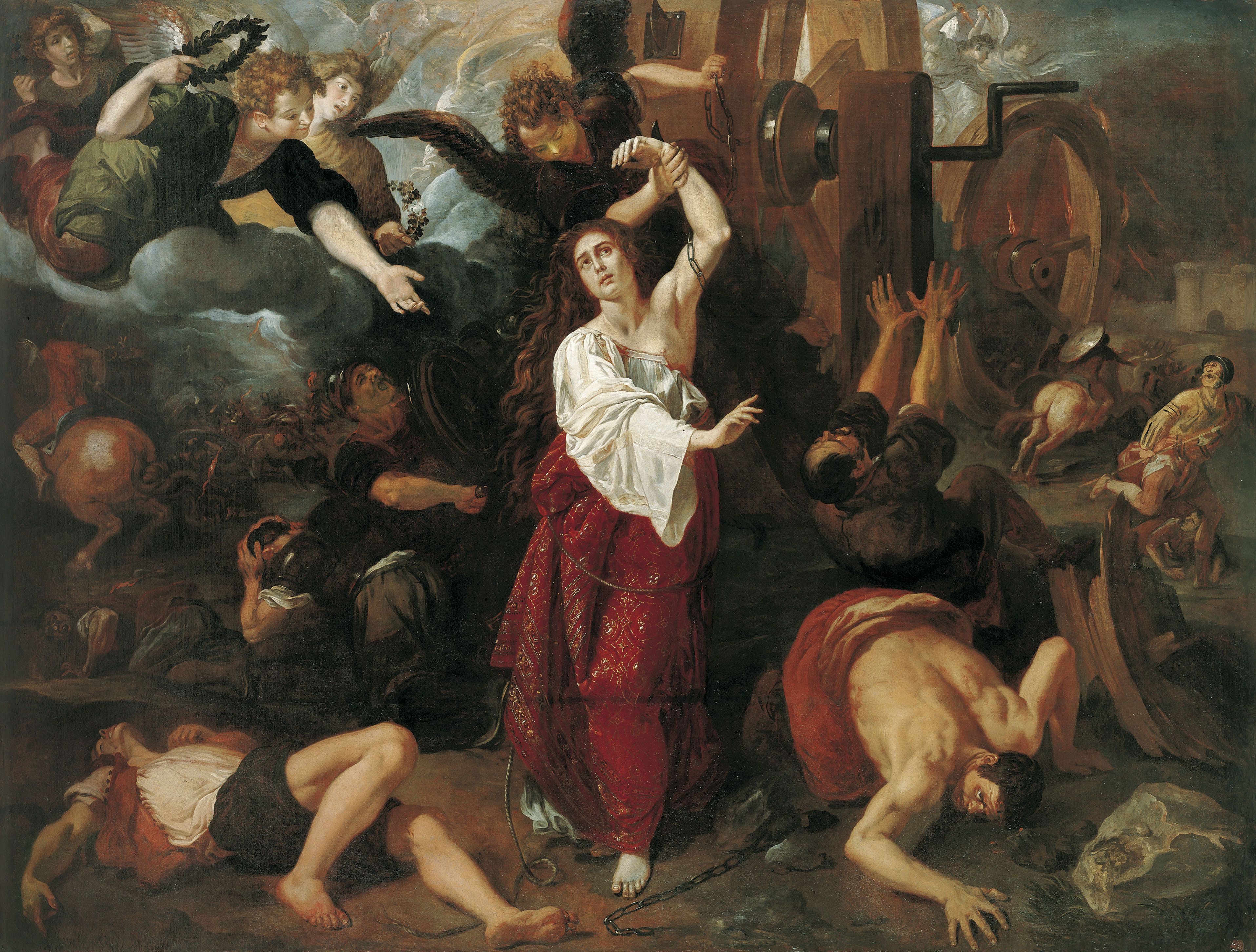
St Catherine was invoked by young women looking for a husband. If you have children, you could use this feast to discuss the qualities of a good spouse. You could bake St Catherine’s wigs and have your discussion as part of the fun (a spoonful of sugar).
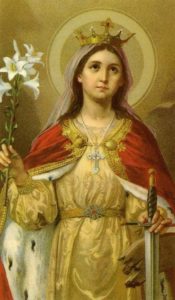
So it was the custom for unmarried women at that time to pray to St Catherine of Alexandria, saying “A husband, Saint Catherine, A good husband, Saint Catherine, A beautiful husband, Saint Catherine, A rich husband, Saint Catherine – and soon, Saint Catherine!
Another prayer to St Catherine of Alexandria for unmarried women is the following O holy virgin and martyr Catherine of Alexandria, beautifully exalted in virtue and wisdom.
You who were able to triumph over the wise men of the empire, I humbly ask you, with all my faith and honesty, to take up my petition to Almighty God and to do the best for me in my love life, so that I may succeed in uniting with one person, since I have not yet met a person whom I can love and have on my path.
You, who are the defender of love unions and who can overcome the most impossible, cover me from the heights where you are with Jesus, your Husband, and by your loving-kindness may you grant me what I ask. Amen.
We leave you with this video of the prayer to St Catherine of Alexandria for the return of your partner:
Miracles of Saint Catherine of Alexandria
St Catherine was born in Alexandria to a patrician family. As a teenager, St Catherine had a vision of Christ, and the Virgin Mary, with a child in her arms, appeared to her in heaven, in the midst of angels and saints, they took a precious ring, given to Him by the Virgin Mary, and it was placed on Catherine’s finger, making her His bride.

After St Catherine’s vision, she awoke to find the same heavenly ring on her own finger, and she remained forever a bride of Christ.
She personally denounced the Emperor Maxentius for his persecution of Christians, and when 50 pagan philosophers were converted by her arguments, she had them burned.
When she refused the bribe of a royal marriage, just as St Ursula had refused to marry the barbarian king, he ordered her to be whipped. He ordered her to be whipped and imprisoned. When he returned home after inspecting the camp, he discovered that his wife, an officer and 200 soldiers had been converted. He had them all killed.
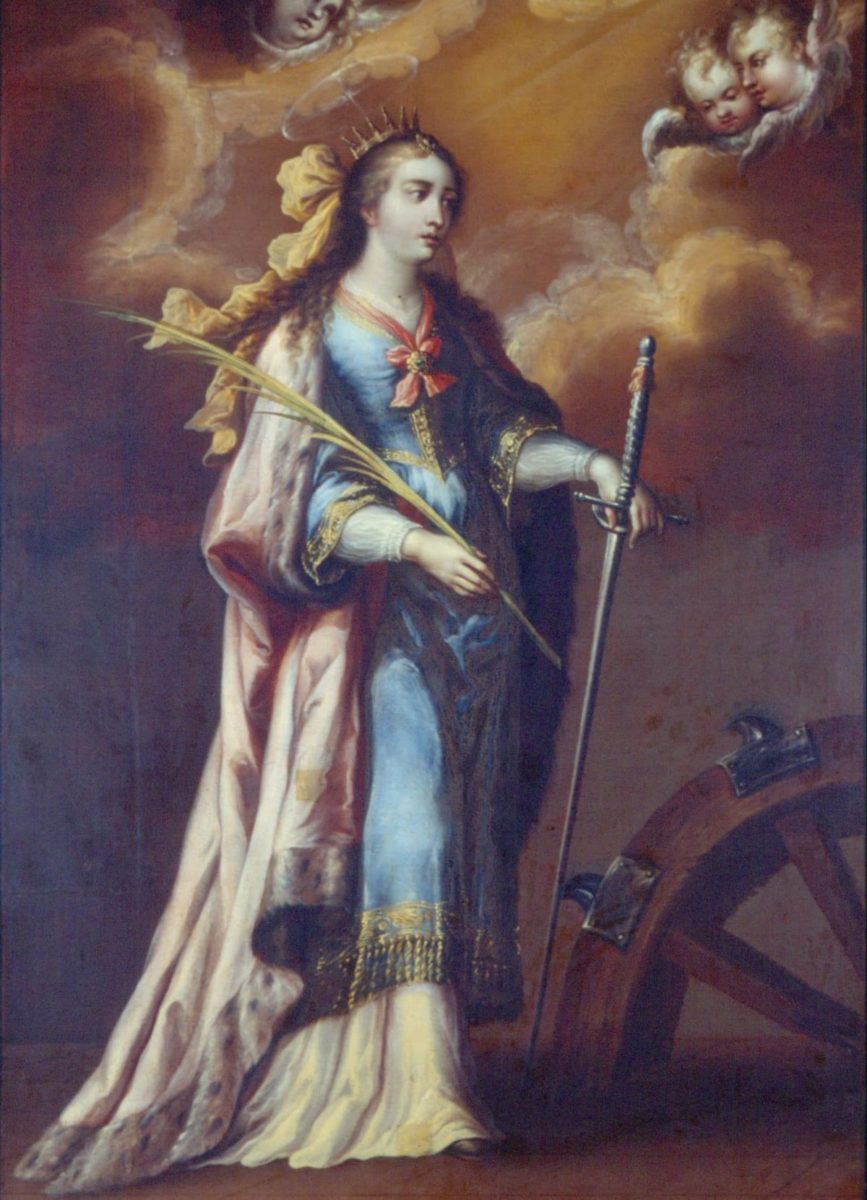
He sentenced Catherine to death on a spiked wheel, but when the wheel miraculously broke, he ordered her beheaded.
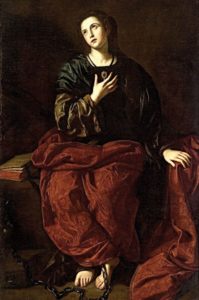
She was led to the place of her martyrdom, followed by several women who wept for her fate. She went joyfully to the appointed place, exhorted all the people who had come to witness her death to abandon idolatry, prayed to God for their conversion, and then received the blow that sent her soul to heaven.
Before she died, she said a prayer and told the soldiers to carry out her orders, and they beheaded her with a swift stroke of the sword.
Soon many miracles began to happen. Her body was carried by angels, as she had requested in her prayer, and buried on Mount Sinai, to rest where God had written His Law in stone.
The Emperor Justinian apparently built a fortified monastery for hermits on Mount Sinai, and Catherine’s body is said to have been taken there in the 8th or 9th century.
The next miracle attributed to her was when the Emperor ordered her to be placed on the wheel of torture through its spokes and her arms torn off.
The hooks and blades bent at the touch of Catherine’s tender flesh and the wheels broke, leaving the saint without so much as a scratch.
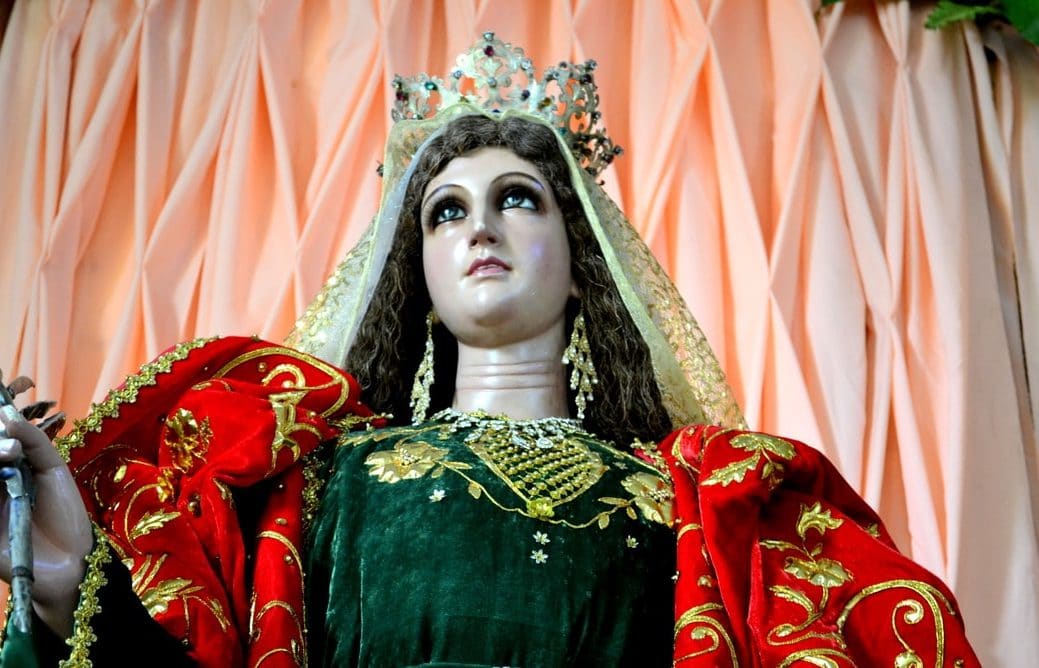
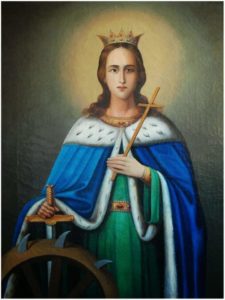 But a beautiful white dove flew through the prison bars, bringing what she needed each day through an opening, so that when she left the terrible prison she was as well as when she entered.
But a beautiful white dove flew through the prison bars, bringing what she needed each day through an opening, so that when she left the terrible prison she was as well as when she entered.Each day she brought what she needed through an opening, so that when she left that terrible prison she was as well as when she had entered.Another miracle attributed to her is that when the Emperor ordered her beheaded, when the sword struck her, instead of red blood, snow-white milk came out of her wounds.
A sign that the whole person was immaculate, without blemish. It is said that oil dripped from her bones for many years; this oil was prized as medicine and for lamps in holy shrines.
God did not allow her body to be deformed, and a swarm of angels came from heaven and took the body of the young girl, rebuilt it, lifted it into the air and carried it to the top of Mount Sinai, where they found refuge in a great church built by St Helena, the mother of Constantine.
Find out more about the Monastery of St Catherine of Alexandria in this video:
The remains of St Catherine are in the Monastery of St Catherine on Mount Sinai. The monastery, a 1,600-year-old fortress at the foot of Mount Sinai, is inhabited by Coptic monks (who are not in union with Rome).
It is said that the burning bush, through which God first appeared to Moses, was located in this chapel. The relics of St Catherine are said to be kept and venerated here.

 Falconius, Archbishop of San Severino, speaks of the removal of Catherine’s body to the top of Mount Sinai. As for what is said about the body of this saint being taken by the angels to Mount Sinai, the meaning is that it was taken by the monks of Sinai to their rich abode, as if it were a great treasure.
Falconius, Archbishop of San Severino, speaks of the removal of Catherine’s body to the top of Mount Sinai. As for what is said about the body of this saint being taken by the angels to Mount Sinai, the meaning is that it was taken by the monks of Sinai to their rich abode, as if it were a great treasure.
It is well known that this is the name of an angelic habit, and that monks were once called angels because of their purity and heavenly functions.
According to the story of St. Joan of Arc, at the age of thirteen she confessed to having seen St. Michael, St. Catherine and St. Margaret, and declared that their voices urged her to lead a devout and pious life.
We leave you with this video of reflection and devotion to St Catherine of Alexandria:
Images of Saint Catherine of Alexandria
Prospero Fontana, an Italian Mannerist painter who lived from 1512 to 1597, painted The Disputation of Saint Catherine, which is one of his greatest works.
There have been other paintings of this miraculous story, but there is something spectacular about the way Fontana depicted the scene.
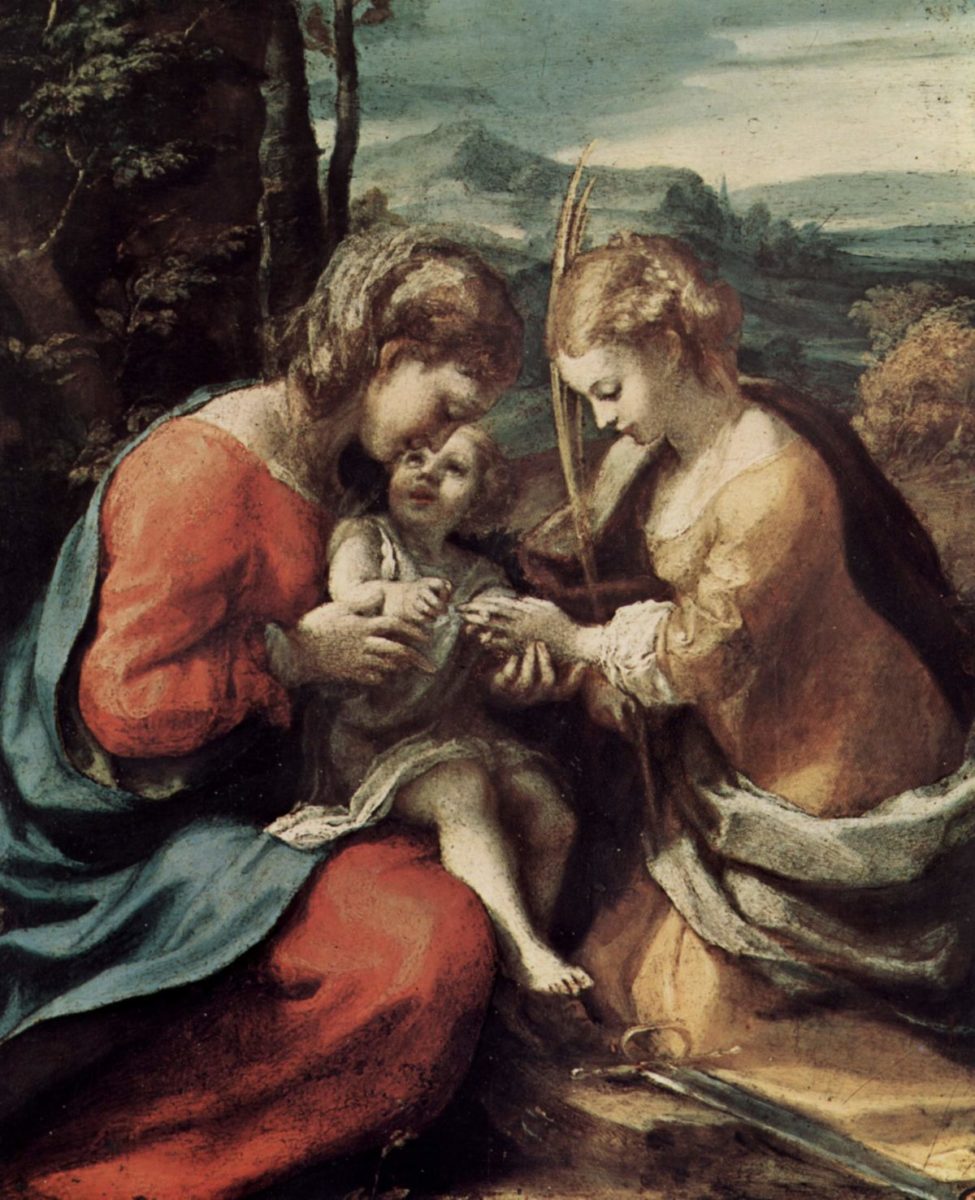
This painting does not show the part of the story that is said to be the miracle of his surviving death at the wheel, but it is still a powerful painting.
The viewer’s eye is drawn to the centre, where St Catherine and Maxentius are debating which religion is right. Surrounding them are the philosophers, who are surprised by what Catherine is telling them, as can be seen by the astonished expressions on their faces.
Catherine points her finger upwards as she explains that there is only one God. In the end, the philosophers realised that there really is only one true God, but they were killed for their decision to follow Christ.
Watch this video to see the meaning of the image of St Catherine of Alexandria:
In another version of the painting, just before St Catherine’s beheading, we see a devout woman kneeling before God with her hands in the position of someone praying.
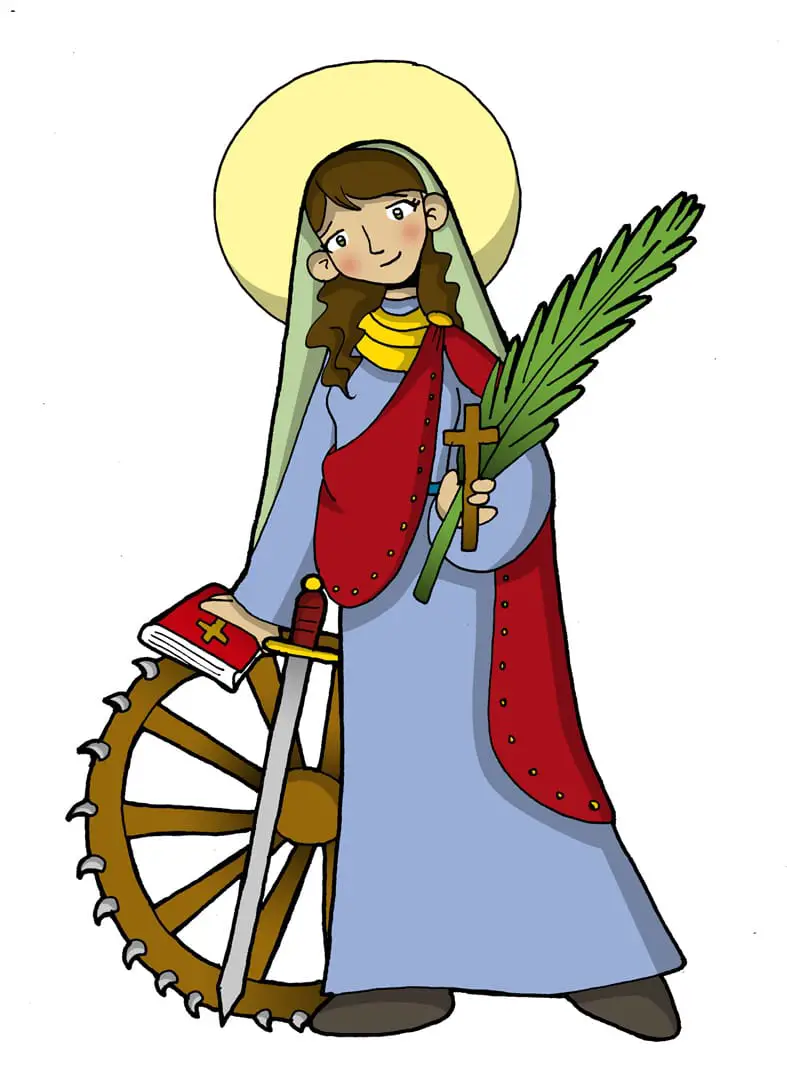
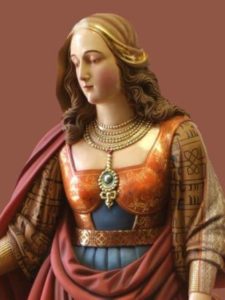
Very calmly he spoke these words shortly before his death: Lord Jesus Christ, my God, I thank you for having set my feet firmly on the rock of faith and for having guided my steps in the way of salvation.
Open now your arms, wounded on the cross, to receive my soul, which I offer in sacrifice to the glory of your name. Forgive the faults I have committed in ignorance and wash my soul in the blood I will shed for you.
Do not leave my body, slaughtered for love of You, in the power of those who hate me. Kindly go to these people and give them the knowledge of the truth. Finally, O Lord, in Your infinite mercy, exalt those who call on You through me, so that Your name may be glorified forever.
His dedication to the Lord’s work, even unto death, is a powerful story of what unconditional love for God looks like.
Listen to the hymn to St Catherine of Alexandria in this video:
Patronage of St Catherine of Alexandria
St Catherine of Alexandria is the patron saint of: people who make crafts with a wheel, e.g. potters, archivists, defenders of the law, the dying, teachers (another patron saint of educators is St John Baptist De La Salle), girls, lawyers, shredders, knife sharpeners, people who work in libraries.

She is also the patron saint of mechanics, millers, nurses, philosophers, preachers, scholars, students, scribes, secretaries, spinsters, stenographers, tanners, teachers, theologians and carters.
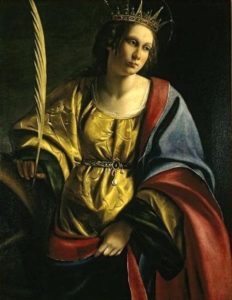
Symbols of St Catherine of Alexandria: set of wheels with sharp knives, broken wheel, sword, crown at her feet, hail, veil and bridal ring, dove, book, spiked wheel, woman tied to the spiked wheel on which she was martyred, woman arguing with pagan philosophers.
The visions of St Catherine of Alexandria have never been investigated or confirmed. Her feast day is 25 November.
Due to the fabulous nature of the account of her martyrdom and the lack of reliable documentation, the Roman Catholic Church removed her feast day from the General Roman Calendar in 1969.
However, she continued to be commemorated on 25 November in the Roman Martyrology. In 2002, her feast day was restored to the General Roman Calendar as an optional commemoration.
Get to know Saint Catherine of Alexandria through this video:

